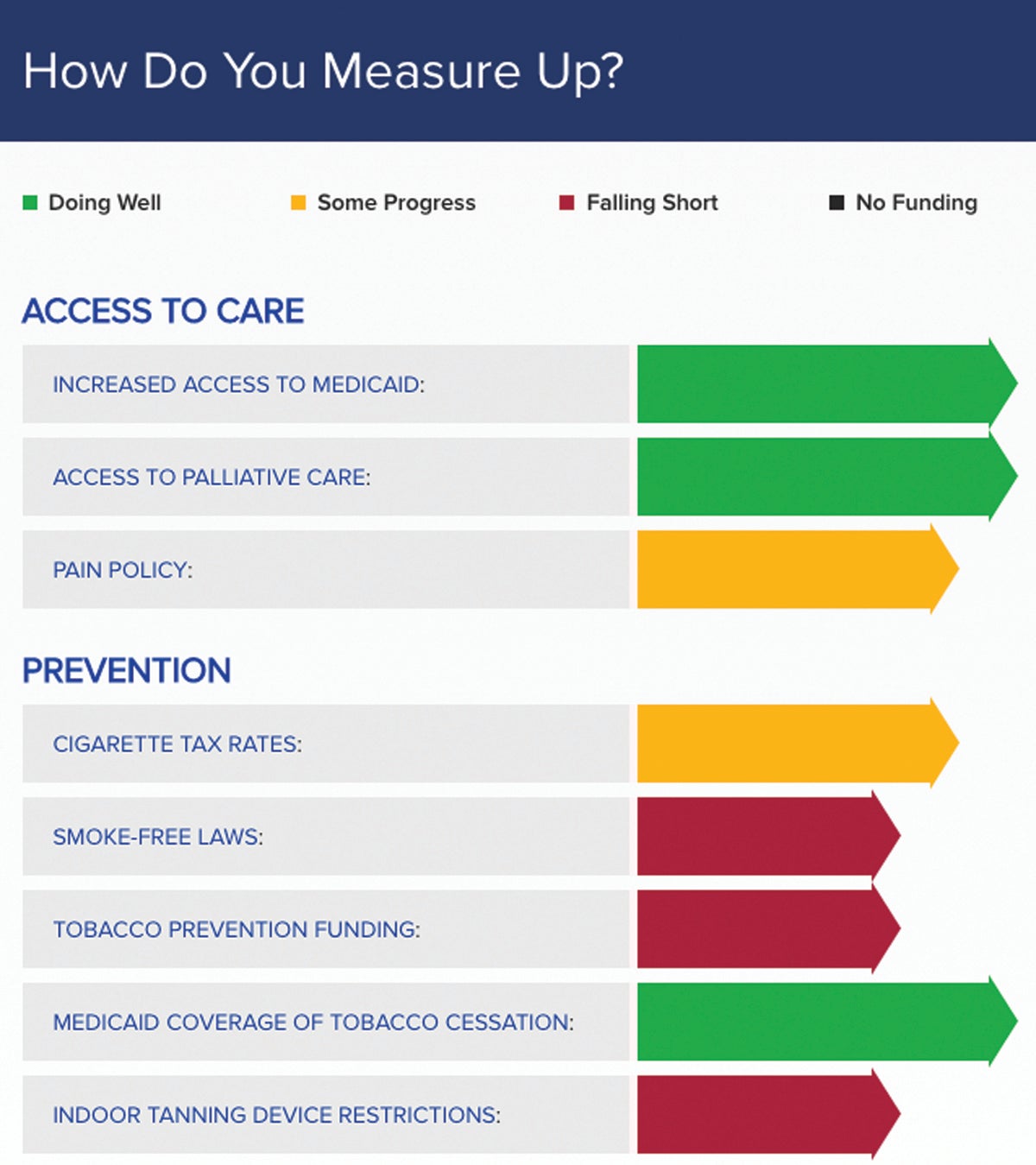Closer Look: Ky. needs work to curb cancer, according to report
Published 1:14 pm Saturday, August 3, 2019
Kentucky made some progress but continues to fall short in some key areas of the fight against cancer, according to the latest edition of “How Do You Measure Up?: A Progress Report on State Legislative Activity to Reduce Cancer Incidence and Mortality.”
How Do You Measure Up? rates states in eight specific areas of public policy that can help fight cancer: increased access to care through Medicaid, access to palliative care, balanced pain control policies, cigarette tax levels, smoke-free laws, funding for tobacco prevention and cessation programs, cessation coverage under Medicaid and restricting indoor tanning devices for people under 18.
A color-coded system classifies how well a state is doing in each issue. Green shows that a state has adopted evidence-based policies and best practices; yellow indicates moderate movement toward the benchmark and red shows where states are falling short.
According to the report, Kentucky still has a long way to go in cancer prevention efforts, especially considering Kentucky is No. 1 in incidences and mortalities from cancer.
According to Ben Chandler, CEO of the Foundation for a Healthy Kentucky, the data confirms what his organization already knew: there is work to be done.
“The data in this report confirms what we already know in areas that we’ve been working on,” he said. “There some progress, but its been slow in Kentucky.”
Doing well
The report indicates Kentucky is among the states that have expanded Medicaid eligibility, covering individuals up to 138 percent of the Federal Poverty Level, or $17,236 per year for an individual or $35,535 for a family of four.
“For the 1.7 million Americans who will hear the words “you have cancer” in 2019, having comprehensive, adequate and affordable health insurance coverage is key to successfully detecting and treating their disease,” the report states. “Medicaid provides health insurance coverage to low-income children, adults, seniors and people with disabilities—many of whom face greater risk of being diagnosed with a late-stage cancer and are more likely to face challenges surviving the disease”
Kentuckians on Medicaid also have access to smoking cessation through their coverage, the report indicates.
Additionally, Kentucky has passed legislation to improve access to palliative care, which is specialized care for someone living with a serious illness like cancer.
According to the report, cancer patients receiving palliative care during chemotherapy are more likely to complete their cycle of treatment, stay in clinical trials and report a higher quality of life. Palliative care reduces unnecessary use of hospitals, diagnostic and treatment interventions, and nonbeneficial intensive care.
A 2016 study showed that giving cancer patients a palliative care consultation within two days of hospital admission reduced costs 22 percent to 32 percent.
The report particularly marks Kentucky as a recent success story for palliative care, mentioning legislation passed in the most recent session.
In March, Gov. Matt Bevin signed a bill into law to “expand awareness and utilization of palliative care throughout the state.” Kentucky is the 25th state to establish a Palliative Care Interdisciplinary Advisory Council as well as a Professional Information and Education Program.
“Hospice and palliative care providers nationwide have long worked to increase public awareness and understanding of their services and misconceptions about these types of care have been a significant barrier to greater utilization,” according to the report. “The Centers to Advance Palliative Care (CAPC) estimates that 70 percent of people in the United States are “not at all knowledgeable” about palliative care. Increasing public awareness can lead more patients to pursue palliative care; CAPC research shows that 92 percent of people who have a good understanding of palliative care say they would seek out this type of care for themselves or a family member.”
Areas of progress
In the areas of pain policy and cigarette tax rates, Kentucky is making some progress.
“Pain is one of the most feared symptoms for cancer patients and survivors,” according to the report. “Nearly 60 percent of patients in active treatment and 30 percent of patients who have completed treatment experience pain. Unfortunately, despite the fact that millions of cancer patients and survivors experience chronic pain, it remains a highly stigmatized issue. Significant disparities exist in pain treatment, with medically underserved and socioeconomically disadvantaged populations experiencing disproportionately restricted access.”
According to recent research conducted by ACS CAN in tandem with the Patient Quality of Life Coalition and Public Opinion Strategies:
— 48 percent of cancer patients and survivors have been told by doctors that their pain treatment options were limited by laws, guidelines or insurance coverage.
— 27 percent of cancer patients and survivors have been unable to get their prescription pain medication because a pharmacist would not fill it, even though they had the medication in stock.
Kentucky falls somewhere between 50 to 80 percent of the ACS’s model policy for pain. In fact, only a handful of states — New Mexico, Virginia, New Hampshire, Vermont and Maine — were above an 80 percent match for the model policy, indicating a national need for more policies to improve access to pain management methods for cancer patients.
“As a nation, we must take steps to identify balanced solutions that address the opioid epidemic, while not creating unintended barriers to access needed opioid medications for cancer patients, cancer survivors and others with serious chronic illness,” the report states.
In Kentucky, the cigarette tax rate is $1.10 per pack, after a 50 cent increase was implemented two years ago.
“(The Foundation) led the fight two sessions ago to raise the rate,” Chandler said. “We wanted to raise the raise by a dollar, but the legislature opted to raise the rate by only 50 cents. While we didn’t get what we wanted, I’m a glass half full kind of guy. We got the biggest cigarette tax increase that the state of Kentucky has seen. Fifty cents is the highest increase that has ever been placed on cigarettes.
“That’s why we showed some marked progress in that measurement.”
Compared to surrounding states, Kentucky’s tax rate is much higher than Tennessee’s 62 cents per pack, but lower than Ohio’s $1.60 and Illinois’s $2.98.
The national average is $1.81 per pack, according to the report.
The ACS indicates that “Regular and significant tobacco tax increases are one of the most effective ways to reduce tobacco use and, therefore, suffering and death from tobacco-related diseases like cancer.”
“We’ve still got a lot of room to increase,” Chandler said.
Falling short
Despite some progress related to cigarettes tax rates, Kentucky continues to fall short in other areas concerning smoking, the report indicates.
Many Kentucky counties do not have smoke-free laws in place, which can reduce second-hand smoke exposure and are shown to reduce smoking rates.
“Only six counties in Kentucky have a comprehensive smoke-free law,” Chandler said.
Smoke-free legislation prohibits smoking in any public buildings including work places, office buildings, restaurants and bars, government buildings and schools.
“Tobacco, of course, has a strong cultural pull in Kentucky,” he said. “Fayette County was the burley capital of the world. It had the largest burley market on the planet. Nevertheless, they decided to go smoke-free and we’ve seen smoking decline and cancer rates decline there.
“It’s about changing societal norms. But also it’s a protection against secondhand smoke for the public.”
“According to the U.S. Surgeon General, there is no safe level of exposure to secondhand smoke, which contains approximately 70 known or probable carcinogens and more than 7,000 other toxic chemicals, including formaldehyde, arsenic, cyanide and carbon monoxide,” the report states. “Each year in the United States, secondhand smoke causes nearly 42,000 deaths among nonsmokers, including up to 7,300 lung cancer deaths. It can also cause or exacerbate a wide range of other health issues, including cardiovascular disease, stroke, respiratory infections and asthma.”
Both the ACS and Chandler would like to see more funding focuses on smoking prevention and cessation in Kentucky.
According to the report, Kentucky offers only less than 25 percent of the Centers for Disease Control and Prevention’s recommended funding toward tobacco prevention.
According to the report, Kentucky has allocated about $3.8 million for tobacco prevention in 2019. The CDC recommends about $60 million in funding for Kentucky, meaning the state fall at only about 7 percent of the recommended funding.
However, Chandler said that doesn’t have to be the case.
“There’s not doubt about it that Kentucky falls short for tobacco prevention and smoking cessation funding,” he said. “And we’re going to be talking to the legislature more about funding for tobacco prevention.”
Chandler said hundreds of millions of dollars are paid to Kentucky annually from the tobacco settlement signed in the late 1990s. He said that money could go toward more prevention efforts in the state.
“Just a tiny bit is spent on smoking cessation and we ought to be spending more,” he said.
Why a focus on smoking, tobacco is important in Kentucky
Chandler said about one-third of cancers in Kentucky are directly related to smoking.
“What that tells me is about one-third of cancers are preventable,” he said.
However, Kentucky has the highest rates of cancer and cancer-related deaths in the country.
According to data from the American Cancer Society, Kentuckians are dying at high rates from lunch and bronchus cancers compared to other cancers.
There have been an estimated more than 26,000 new cases of cancer diagnosed in Kentucky in so far in 2019. Of those cases, most are lung or bronchus cancers (4,960) followed by female breast cancer (3,670), colorectal cancer (2,320), prostate cancer (2,190), melanoma skin cancer (1,310) and kidney and renal pelvis cancers (1,220).
Already this year, approximately 10,500 people have died from cancer, most of those being attributed to lung and bronchus cancers (3,290). The number of death related to lung and bronchus cancers are significantly higher than other cancers; the next highest number of deaths were attributed to colorectal cancers (820).
While the incidence rates of breast cancer (125) and prostate cancer (108.8) were higher than lung and bronchus cancers (93.5) from 2011-15, the death rates for lung and bronchus cancers were significantly higher (66.1) from 2012-16 compared to breast cancer (21.6) and prostate cancer (19.9).
Although Kentuckians die at high rates from lung and bronchus cancers, rates of smoking, including among teens, remain higher than the national average in the state.
The American Cancer Society reported about 25 percent of adults reported being current smokers in 2017 compared to the 17 percent national average and 14 percent of high schoolers reported being current smokers compared to the nation’s 9 percent average. Kentucky ranked second highest in the country for both rates of adult and high schoolers as current smokers.
“Smoking harms everything in your body from head to toe and exacerbates illnesses that you already have,” he said. “The one I focus on most is cancer. We have the highest cancer rates in the country and also the highest morbidity rates. More people get cancer in Kentucky than any other place in the U.S. and more people die from cancer in Kentucky than any other place in the U.S.
“That in my mind is totally unacceptable. We ought to do everything in our power to prevent those cancers, and the very best thing we can do is cut the smoking rate.”
Indoor tanning
The report also indicates that Kentucky is one of many states that does not have a state law prohibiting indoor tanning for minors with no exemptions.
According to there report, skin cancer is the most commonly diagnosed cancer in the U.S., and the greatest avoidable known risk factor for skin cancer is the use of indoor tanning devices.
In Kentucky, anyone under the age of 14 must be accompanied by a parent or guardian when tanning. Teens between ages 14 and 18 must have written parental consent before using tanning beds.
What can be done
Kentucky legislators have the opportunity to work with advocates and research groups to implement policies that help in the fight against cancer, according to the report.
Some steps to be taken include:
— Implementing stronger smoke-free laws. According to the report, as of July 1, 27 states, Puerto Rico, the U.S. Virgin Islands, the District of Columbia and more than 1,050 municipalities across the country have laws in effect that require 100 percent smoke-free workplaces, including restaurants and bars. Kentucky is not one of those states. The only way to reduce exposure to secondhand smoke is to make all public places, including all workplaces, restaurants, bars and gaming facilities, smoke-free, the report argues.
— Increase funding for tobacco prevention. Kentucky falls at less than 25 percent of the Centers for Disease Control and Prevention’s recommended funding level for tobacco prevention, according to the report. The 2014 U.S. Surgeon General’s report on tobacco concluded that comprehensive statewide and community tobacco prevention and cessation programs reduce tobacco use by keeping young people from becoming addicted and helping individuals who use tobacco to quit.
— Implement stricter laws regarding indoor tanning devices. Laws that prohibit the use of indoor tanning devices for individuals under the age of 18 are effective in deterring minors from using tanning devices and can help to reduce skin cancer incidence and mortality rates across the country.





